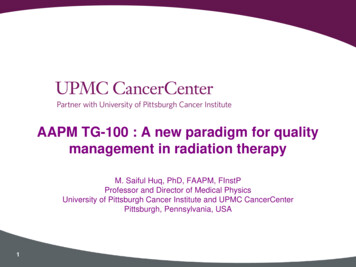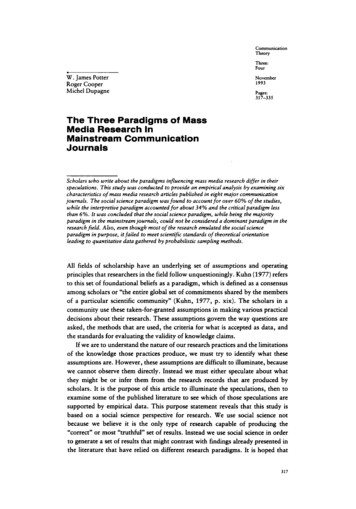
Transcription
AAPM TG-100 : A new paradigm for qualitymanagement in radiation therapyM. Saiful Huq, PhD, FAAPM, FInstPProfessor and Director of Medical PhysicsUniversity of Pittsburgh Cancer Institute and UPMC CancerCenterPittsburgh, Pennsylvania, USA1
Disclosures 2I have nothing to discloseSaiful Huq – AAPM TG100: ORVC and Penn-Ohio Chapter Meeting, 2013
Acknowledgement Special thanks to Frank Rath from the University ofWisconsin because I have taken many slides shown in thispresentation from his summer school presentations.3Saiful Huq – AAPM TG100: ORVC and Penn-Ohio Chapter Meeting, 2013
Authors of TG100Benedick FraassM. Saiful HuqGeoffrey Ibbott(Chair)Peter DunscombeJohn GibbonsSasa MuticEllen Yorke(Vice Chair)Arno Mundt4Bruce ThomadsenJatinder PaltaFrank RathSaiful Huq – AAPM TG100: ORVC and Penn-Ohio Chapter Meeting, 2013Jeffrey Williamson
TG100 analysis of causes of failure for IMRTLack of resources6%InadequateDesign failure ication10%Inadequate training15%5Saiful Huq – AAPM TG100: ORVC and Penn-Ohio Chapter Meeting, 2013Lack ofstandardizedprocedures15%
Recent reportsAs technology and processes change Retrospectiveapproaches to QM are notsufficient All-inclusiveQC checks may not befeasible Developproactive approaches to failuremodes200020086 Evaluaterisks from each failure mode Developrisk based approaches to QM2009Saiful Huq – AAPM TG100: ORVC and Penn-Ohio Chapter Meeting, 201320082012
Safety approach in industry Hazard identification and control approach is the basis forsafety planning procedures for manufacturing The design phase of the ISO safety strategy includes identifications of hazards assessment of the associated risk removal of the hazards as much as practicableSaiful Huq – AAPM TG100: ORVC and Penn-Ohio Chapter Meeting, 2013
Quality management in industry Systematic application of specific tools that improve processcontrols producing more consistent and closer to optimaloutcomes and reduce the risk of mistakes, errors orhazardous outcomesSaiful Huq – AAPM TG100: ORVC and Penn-Ohio Chapter Meeting, 2013
Process controls Process controls for grilling a steak– Experience/training – how much charcoal to pile in themiddle of the grill, etc.– Measurement tools – watch (steak goes on the grill 20minutes after igniting the coals)– Because there are some variables that are difficult tocontrol – meat thermometer (135 deg. F)9Saiful Huq – AAPM TG100: ORVC and Penn-Ohio Chapter Meeting, 2013
Healthcare environment Can the concept of risk identification and process control beapplied to healthcare to improve the quality of care for patients? Yes, of course. Healthcare situations readily lend themselves toa similar risk identification and control approachSaiful Huq – AAPM TG100: ORVC and Penn-Ohio Chapter Meeting, 2013
What is risk? Risk: frequently defined as the answers to three questions What can go wrong? How likely is it to go wrong? What are the consequences if it goes wrong?Saiful Huq – AAPM TG100: ORVC and Penn-Ohio Chapter Meeting, 2013
Risk assessment Risk assessment is the process of analyzing the hazardsinvolved in a process Many risk assessment and analysis tools/techniquesexist in industry These tools can be easily adapted to RT to enhancesafety and quality of treatment process TG100 used some of these tools to develop newguidelines for RT QMSaiful Huq – AAPM TG100: ORVC and Penn-Ohio Chapter Meeting, 2013
Risk assessment tools Process tree (mapping) Failure mode and effects analysis (FMEA) Fault tree analysis (FTA) Establishment of a risk based QM programUsed IMRT as a casestudySaiful Huq – AAPM TG100: ORVC and Penn-Ohio Chapter Meeting, 2013
What is a process tree? Visual representation of the various steps in a process Demonstrates the flow of steps from process start to end Delineate and then understand the steps in the processSaiful Huq – AAPM TG100: ORVC and Penn-Ohio Chapter Meeting, 2013
Simple example of a process mappatient enterslinac vaultsetuppatient toCT marksshiftTP shiftinstructiontreatCourtesy: Darek Brown15Saiful Huq – AAPM TG100: ORVC and Penn-Ohio Chapter Meeting, 2013
Complicated example: TG100 IMRT process treeSubsequent tx(Day N)Immobilizationand positioningTreatment planningOther pretreatment imagingInitial treatmentplanning directivePlan preparationStart of txEnd of txPatient databaseinformation enteredTransfer images andother DICOM dataCT simulationPlan approvalRTP anatomycontouringSaiful Huq – AAPM TG100: ORVC and Penn-Ohio Chapter Meeting, 2013Initial tx(Day 1)
TG100 IMRT process tree8 Treatment planningSpecify ROI for optimization 1910 PlanpreparationEnter prescriptionAnd planning constraints 18, 21, 452 Immobilizationand positioning4 Other imagingSetup fields6 Initial treatmentplanning directivePatient informedOf imaging requirementsCalculate doseto optimization pointsand dose distribution 12, 31Immobilizationequipmentdocumented,labeled, and storedImaging anddiagnosisReview of patientmedical historyPositioningPt changes noted 42Optimization/Dose calculation 12, 31Order fieldsImagingPrepare paper chartTreatment accessories 24Optimizationsettings 45Prepare electronic chart 15OptimizationROI 33, 44Special Instructions(pacemakers, allergies,preps, etc.) 9ImagesInterpreted 1Pt prep 35Define localization imagingHeterogeneity correction 30Specify registration goals 23, 38Suggest initial guidelines fortreatment parametersMake imagesPatient informationAnnotate localization anatomyIndicate motion/uncertaintyManagement 13, 14PositionpatientDelivery protocolsPrepare DRR and other imagesSpecify protocol for delineatingtarget and structures 17Immobilizationequipment fabricated12 SubsequenttreatmentsSchedulingSetup dosecalc parametersSpecify images fortarget/structure delineation 11Enter demographicsSpecify treatment courseMotionManagement 8Treatment 3Check version ofplan and patient IDAutomatic data entry and plan modificationRun leaf sequencerTransfer patient data to treatment delivery 15Evaluate leaf sequencerSpecify dose limits and goals 26Manual data entry and plan modification 39Tx Unit operationand calibration 3SchedulingMonitor Pt/Tx 37, 43Evaluate plan 10, 28Account for previous treatmentsor chemotherapy 4Evaluate deliverysystem limitationsChanges noted 32, 34Changes correct 40, 42DocumentationSuccessful treatmentSave patientPatient PositionRecorded in databaseData into electronicDatabase 22Data into writtenchart 22Information onPrevious orconcomitant treatment 221 Patient databaseinformation entered4D representationTransferOther datasetsImaging StudiesImmobilization equipmentdocumented,labeled, and storedTransfer CTDataset 41Delineate ROIs andplanning structuresProtocol for PTVMargin 65 TransferimagesSpecify PTV MarginMonitor Pt/Tx 37, 439 PlanapprovalTx Unit operationand calibration 3Motion management 8Boolean operations 29, 46MD: delineateGTV/CTV 2,5Protocol for delineationof targets 17Import and fuse images 16Treatment accessories 24Treatment settingsImaging (port films, CBCT, etc) 27Set up datadocumented3 CT simulationDocumentationTreatment 3PTV constructionPatient prepped(contrast, tattoos,BBs etc.)Patient IdentifiedApproveplan 7, 20Edit density mapfor artifactsImmobilization forImaging studyImmobilizationequipmentfabricatedComplete formalprescription 36Select Images 254D imaging correct 13Create casePositioningPatient information 357 RTP anatomycontouringTime outPatient IDTreatment Site11 Initial treatment17Saiful Huq – AAPM TG100: ORVC and Penn-Ohio Chapter Meeting, 2013Treatment settingsChart filing
FMEA A risk assessment tool used to identify weaknesses ordeficiencies (inadequate controls) in processes that couldlead to mistakes, errors, and potential hazardous outcomesSaiful Huq – AAPM TG100: ORVC and Penn-Ohio Chapter Meeting, 2013
Strategy for improving patient safety: FMEA & FTA Begins with a complete and thorough understanding of theprocess – flow charts, process maps Perform a Process FMEA (P-FMEA) to identify weaknessesor inadequate controls in the process Develop process controls that either reduce the risk orimprove the process Use FTA to identify root causes of potential process failuresand develop recommendations to improve quality control ofthe processSaiful Huq – AAPM TG100: ORVC and Penn-Ohio Chapter Meeting, 2013
Completing an process FMEA Create a team Ideally cross functional representing every function involved in theprocess Oncologists, medical physicists, dosimetrists, therapists, ITpersonnel, administrators Effort should be led by a facilitator trained in or familiar with the toolsused in the analysis Consider providing trainingSaiful Huq – AAPM TG100: ORVC and Penn-Ohio Chapter Meeting, 2013
Completing an process FMEA Select a process – key step Scale is important Opportunity – Quality issues, past problems, not happy with the levelof success, Realistic opportunity to make improvements Complexity or sizeSaiful Huq – AAPM TG100: ORVC and Penn-Ohio Chapter Meeting, 2013
Process FMEA – for each step in a processFM: Inability of a processstep to produce thedesired optimal outcomeDetectFailureModesEffectsCauseSaiful Huq – AAPM TG100: ORVC and Penn-Ohio Chapter Meeting, 2013
Completing an FMEAFor a given process:StepPotentialfailuremodesPotentialcauses offailurePotentialeffects offailureOS D RPNRPN O x S x D [ 1 RPN 1000 ]23Saiful Huq – AAPM TG100: ORVC and Penn-Ohio Chapter Meeting, 2013Comment
Completing an FMEA1. For each process step – identify all potential failure modes– always best to define failure modes as “not” meetingprocess requirements2. For each potential failure mode – identify all of the causesthat could produce that failurea. Focus on process related causes of failure modesSaiful Huq – AAPM TG100: ORVC and Penn-Ohio Chapter Meeting, 2013
Completing an FMEA3. For each potential failure mode – identify the effects of thatfailure modeSaiful Huq – AAPM TG100: ORVC and Penn-Ohio Chapter Meeting, 2013
Completing an FMEA4. Current controls – judge the current capabilities ofthe process controls to:a. Prevent the cause of a failure from occurringb. Detect a failure when it occursc. Moderate the severity of a failure when itoccursSaiful Huq – AAPM TG100: ORVC and Penn-Ohio Chapter Meeting, 2013
Completing an FMEA Most effective and lowest cost controls are those thatprevent causes of failure modesSaiful Huq – AAPM TG100: ORVC and Penn-Ohio Chapter Meeting, 2013
FMEA ranking scales for Occurrence, Detection, Severity*Occurrence of the cause of failure mode : ODetection of failure mode: DSeverity of the effect when failure mode occurs: S*Not used by TG100Saiful Huq – AAPM TG100: ORVC and Penn-Ohio Chapter Meeting, 2013
Completing an FMEA Risk Priority Number (RPN) Occurrence ranking X Severity ranking X Detection ranking Range of RPNs (1 -1000) RPN of 125 or higher is problematic either in terms of safety orprocess capability29 Typical scenario –RPNs over 400! Highest RPNs must be addressed first Then work down to lower risk process stepsSaiful Huq – AAPM TG100: ORVC and Penn-Ohio Chapter Meeting, 2013
Completing an FMEA Risk Priority Number (RPN)– Beware of patterns potentially hidden by low overall RPNs Occurrence 10, Severity 10, Detection 1 - RPN of 100 but Occurrence 1, Severity 10, Detection 10 – RPN of 100 but . Severity of 10 – even if Occurrence and Detection are both a 1can you or do you want to risk it?30Saiful Huq – AAPM TG100: ORVC and Penn-Ohio Chapter Meeting, 2013
Top/Down FMEA approach Start with the major “branches” of the selected process Perform a PFMEA to identify which ‘branches” are theweakest (most likely to produce sub-optimal results orerrors/mistakes Drill down deeper into those “branches” – more detailedprocess map and PFMEASaiful Huq – AAPM TG100: ORVC and Penn-Ohio Chapter Meeting, 2013
Fault TreeEvaluates propagation of failuresVisual representation of propagation of failuresBegins on the left with a failure modeWorks backwards in time(to the right to identify causes of failure)32Saiful Huq – AAPM TG100: ORVC and Penn-Ohio Chapter Meeting, 2013
Fault TreeEvaluates propagation of failuresError in dataVisual representation of propagation of failuresBegins on the left with a failure modeError invalueWorks calculatedbackwardsfor patientORin time(to the right to identify causes of failure)Error in datainputError incalculationalgorithmError inprescription33Saiful Huq – AAPM TG100: ORVC and Penn-Ohio Chapter Meeting, 2013
Fault TreeErrorin dataErrorin QCError indata inputError inCalculatedvalue forpatientError incalculationErrorin QAErrorin QCError inCalculationalgorithmErrorin QCError inprescriptionErrorin QC34Saiful Huq – AAPM TG100: ORVC and Penn-Ohio Chapter Meeting, 2013
Saiful Huq – AAPM TG100: ORVC and Penn-Ohio Chapter Meeting, 2013TG100
Summary Current QA guidance documents are based on prescriptiveapproaches evaluating technical performances ofradiotherapy equipment There has been a growing recognition that quality andsafety impairment arises from weakness in radiotherapyprocesses Hence the change in approach in QM in TG10036Saiful Huq – AAPM TG100: ORVC and Penn-Ohio Chapter Meeting, 2013
Thank youIt is useful to reportall accidents beforeconsequences appearIt is impossible to make anythingfoolproof because fools are soingenious.Arthur Bloch, Murphy’s lawOur job is not to preventerrors, but to keep theerrors from injuring thepatients.Lucian LeapeSaiful Huq – AAPM TG100: ORVC and Penn-Ohio Chapter Meeting, 2013
Saiful Huq - AAPM TG100: ORVC and Penn-Ohio Chapter Meeting, 2013 Risk assessment Risk assessment is the process of analyzing the hazards involved in a process Many risk assessment and analysis tools/techniques exist in industry These tools can be easily adapted to RT to enhance safety and quality of treatment process











